So you’ve decided you’d like to get a Mac, but what now? All you’ve known up to this point has been PC’s, and you’re very comfortable using Windows, so the prospect of learning a totally new system seems a little daunting. Luckily for you, that’s exactly what we’re going to cover in this article on The Web Squeeze today.
This hasn’t been written to convince you to switch to Mac, and it definitely hasn’t been written to dredge up the age-old “Mac vs PC” debate. We’re simply assuming that you want to get a Mac, and you also want to know what to do next.
So let’s begin!
1.) Choosing a Mac
One of the best things about choosing a Mac is that it’s so simple. There aren’t hundreds of products, there are just a few, and each is targeted towards a specific market. Once again, there’s far too much to cover here, so I’ll stick to what’s probably relevant to you, who is probably a web designer.
There are two options which I would recommend most, and they are an iMac, or a 15″ Macbook Pro. Why? Because you need more power than a Macbook or a Mac Mini, but you definitely don’t need as much power as a Mac Pro.

The iMac
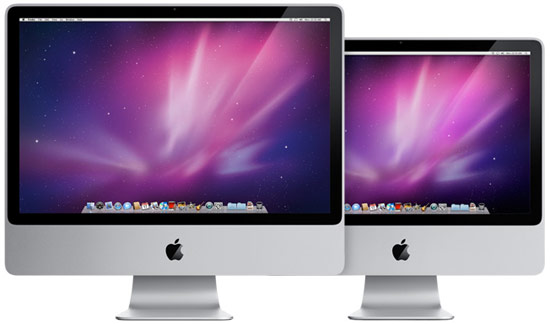
The iMac is your desktop option, and at a very reasonable price, is an absolute monster when it comes to power. For less money than any Apple laptop, an iMac will give you a huge screen (20″ or 24″), a great processor and graphics cards, and a nice big hard dive. Out of the two options that I’m covering here, the iMac is the cheaper option – and it’s a really great one. The only downside is that you sacrifice portability.
The Macbook Pro

The 15″ Macbook Pro is your laptop option, and a far more expensive road to go down. Why the 15″ ? Well the 13″ is much too small to be your primary machine unless you get an extra monitor, and the 17″ is much too big, too expensive, and is much more suited to video editing than web design.
The Best of Both
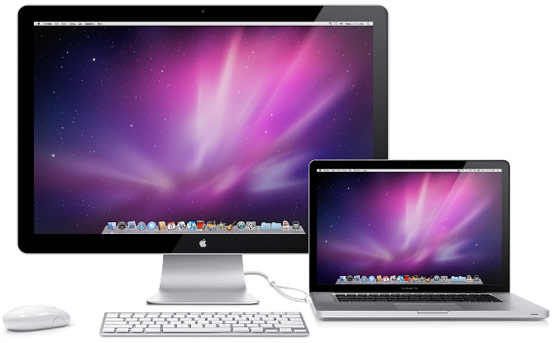
The ultimate setup (in my opinion) is to get yourself a 15″ Macbook Pro, and 24″ Apple Cinema Display, which gives you the best of both worlds. You effectively have an iMac when you’re at your desk, and a really great laptop when you’re not. Chris Spooner has this exact setup, as pictured below.
2.) Getting To Know OSX
So you’ve got your Mac! Congratulations! Not let’s get to know the operating system that you’ll be working with – this is going to be a lot easier than you might be anticipating.
First thing’s first, OSX stands for “Operating System 10″ (X being the Roman numeral for 10). At the time of writing, the most recent version of it is OSX versopm 10.5.6 – “Snow Leopard”.
The first thing that you need to understand about switching from a Mac to a PC is that almost everything that works on a PC, will work on a Mac – it’s only the other way around the problems arise. For example a Microsoft keyboard and mouse will work on a Mac, and you’ll have no problem opening Microsoft Office documents – Apple WANT PC users to switch to using a Mac, so they’ve made all this stuff as easy as possible.
The second thing that you need to understand is that, contrary to popular opinion, you CAN right click on a Mac, and it does the exact same thing as it does on a PC. If you’re using an Apple mouse you simply click down on the right-hand side of the device, or if you’re using a trackpad then you just click with 2 fingers instead of one.
The Desktop
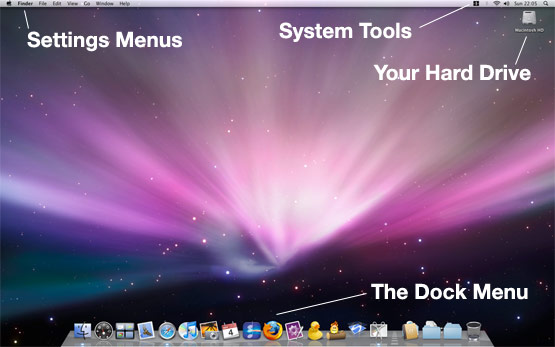
This is the desktop, it doesn’t look too daunting, right? I’ve labelled all the most important things here
The Finder
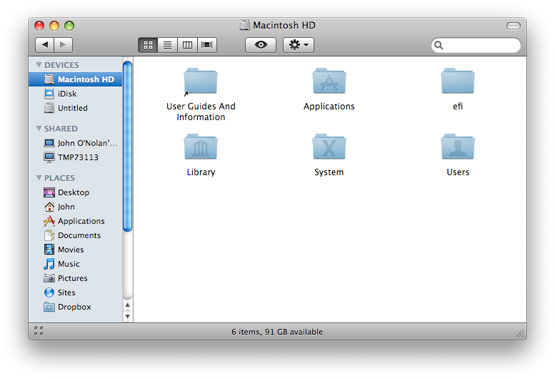
The Finder is like Windows explorer, and it works in the exact same way really – this is how you navigate through and organise all of your files and folders.
The Dock Menu
![]()
This is the Dock Menu, typically it’s at the bottom of the screen but you can move it to the left or right hand side of the screen instead if you prefer. The Dock Menu is where you launch your most-used applications from. It’s the equivalent of going to “Start > Programs” on Windows.
You can have as few or as many applications in the Dock Menu as you like. The above screenshot is my own Dock which, as you can see, is a little crowded.
Installing An Application
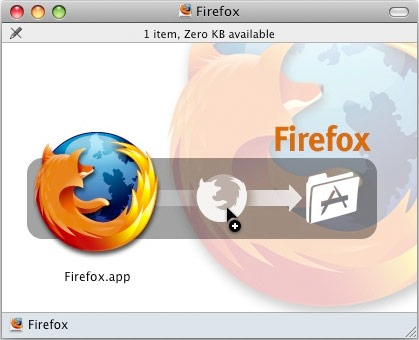
If you want to install an application on a Mac, it couldn’t be easier. Simply download and extract the application that you want, then open the Finder, and click+drag the application icon into the “Applications” folder. That’s it, it’s installed. (Yes it really is THAT easy). If you want to uninstall it, guess what? Just click and drag the icon from the “Applications” folder, down to the trash-can in your dock menu. Done!
Some applications (like Firefox, above) even provide a shortcut to your applications folder, so all you have to do is drag the icon from the left, to the right.
But Wait, There’s More!
So you’re starting to see how all this Mac stuff works now, everything is extremely straightforward, and you know how to browse through your files, install applications, and open them. Hopefully you’re starting to get used to the close/maximise/minimise buttons being on the left corner rather than the right.
Let’s look at some common things that you do on a PC that you’ll want to know how to do on a Mac.
The Command Key
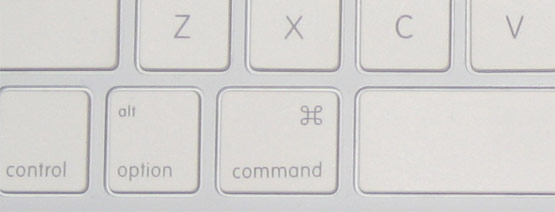
Firstly, let’s talk about the “Command” key. The command key is the little 4 leaf clover immediately to the left and right of your spacebar. For all intents and purposes, the command key performs EXACTLY the same functions as the “Control” key on a Windows machine. The confusing part is that Mac keyboards DO also have a Control key, and the Command key is located in the same place as the “Windows” key on a PC keyboard. As a rule of thumb, the Control key is almost NEVER touched during day-to-day Mac usage.
Common Keyboard Shortcuts
Deleting a file – On a PC you’d press the “delete” key, on a Mac you press Command+Backspace
Copying a file – On a PC you’d press Ctrl+C, on a Mac you press Command+C
Pasting a file – On a PC you’d press Ctrl+V, on a Mac you press Command+V
Creating a new file – On a PC you’d press Ctrl+N, on a Mac you press Command+N
Printing a file – On a PC you’d press Ctrl+P, on a Mac you press Command+P
Are you seeing some similarities here? Most keyboard shortcuts follow this pattern, there are only a couple of commonly used ones that don’t:
Quitting an application – On a PC Alt+F4, on a Mac you press Command+Q (for Quit)
Terminating an unresponsive program – On a PC you’d press Ctrl+Alt+Delete, on a Mac you press Command+Alt+Escape. (trust me, you won’t need to use this one often)
3.) Popular Mac Applications for New Users
There are a few important apps that I recommend to new Mac users who have just come from a PC, mostly because they fix compatibility issues, or just let you do things that you’d normally do on Windows that aren’t built into OSX by default.
The first two are to maximise the compatibility of video files, so that you can play any video file on your Mac regardless of whether it originally came from a Mac or a PC.
Perian

The first one is called “Perian” – which is really more of a plugin than an applications. It simply installs a whole variety of video codecs so that your Mac will be able to play almost any video filetype natively.
VLC Media Player
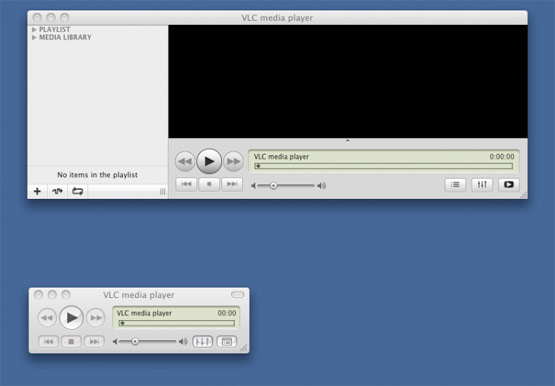
The second on is called VLC – which is a popular media player for PC as well as Mac. It will play almost any file type, and in my opinion it’s better than Quicktime.
Adium
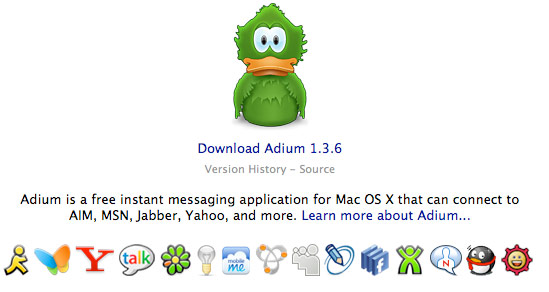
For instant messaging, you want to get your hands on Adium, which is a chat client that supports multiple instant messaging services, including MSN, YM, GTalk, and AIM amongst others.
FontCase

For managing fonts you should definitely check out FontCase.
LittleSnapper

For easily collecting and managing screenshots you should definitely check out LittleSnapper.
There’s Still Much More
Beyond that there are so many more amazing applications for Mac both for web development and many, many other things. You can find some great showcases and reviews over at the Mac.Appstorm blog.
4.) Conclusion & FAQ
Hopefully from reading this article you’ve picked up the basics of how Macs work and understand how to use OSX. It really is very similar to Windows, everything is just a bit easier, a bit quicker, and a bit more pretty to look at.
We’ll finish up with some Frequently Asked Questions:
Q – How do I get my files from my PC to my Mac?
A – The easiest way to do this is to simply put the files on an external hard-drive and then plug the hard drive into your new Mac, and click-and-drag them across. More info
Q – What about Microsoft Office? Can I still use that on my Mac?
A – Yes, you can. The latest version is Microsoft Office for Mac 2008, which looks and behaves almost exactly the same as MS Office 2008 for PC. More info
Q – Are files from my Mac compatible with a PC?
A – For the most part, the answer is yes – and almost all applications allow you to select “windows friendly mode” when you go to save a file.
Q – I have a program for Windows that I can’t live without, but it’s not available for Mac, now what?
A – All new Macs come with the BootCamp utility, which means that you can install a copy of Windows on your Mac so you can still use any PC-Only programs whenever you need to. It’s really easy too. More info
Q – Is there anything I should know about that a PC can do but a Mac can’t?
A – For some reason, Apple have yet to introduce the Solitaire or Paint apps to OSX, but that’s about it.
5.) Further Reading
PC to Mac
A Short Video by Apple Showing the Basic Features of OSX
Switching to Mac
Site Encompassing Many, Many Different Tips & Tricks for Macs
How To Switch To Mac
Article for Advanced Technical Users
Some General Tips for Switching To Mac From Windows
Some Great Quick Tips
Five Reasons Why Developers are Switching to Mac
Smashing Magazine Article specifically for web designers/developers
My First Mac
Buying Tips and Getting Started

I made the switch last year and I love it! It was very easy for me, like I’ve always used one.
Cracking article John. When I first read the title I thought it could be one of those “Macs are better than PC” articles but it was nice to see that it wasn’t. I did an article covering my first week on Mac at Apple Forever, hope you don’t mind the link: http://www.appleforever.com/apple-articles/jacks-mac-diary-part-1.htm
I’ve found Mac to be a much for pleasing experience to work with when compared to Vista and I certainly will always buy Mac in the future.
Really useful article, I wish I’d have had this when I made the switch a couple of years ago.
Believe it or not I didn’t know you could tap the trackpad on a Macbook with 2 fingers to right-click.
You learn something new everyday.
Yeaaaa boyyyy!
Great article John never fails!
Nice article. I won’t be making the switch any time soon. I’ve grown up on Windows PCs. I know them inside and out. If I have a problem with a bit of software I know how to fix it and if I have a problem with a bit of hardware (a network card for instance) I can have it swapped out in a jiffy.
This is where Macs fail for me. Users are not only not given the option to upgrade specific parts, you risk voiding your warranty if they do so. I’ll accept that Mac software is cheap, particularly the OS, but the hardware is NOT. People that say it is are kidding themselves.
I recently spec’d up a an iMac. The upgrade to 8GB of memory was £800!! The same memory from Crucial: Less than £50, delivered. But of course if you buy the machine and then upgrade yourself, bang goes your warranty. Let’s not forget that the top end MacBook Pro is pushing £2000. Hardware wise it’s not that impressive either, for the money.
Also. Cinema displays are THE biggest scam Apple have going. The contrast ratio and response times are appalling, especially for the extortionate prices they charge for them. If you insist on having a nice extra monitor for your Mac, Asus do a 24 inch full HD display with contrast ratio and response time that leave the Apple display in the dust for around £350.
I understand that there’s a market for Macs, I guess I’m just not a part of it. I find that it’s far too much about fashion, as much as Apple geeks will argue. If there comes a day I want OSX, I’d probably take my chances legally and install it on a HP machine and save myself several hundred quid.
Just my 2 cents, sir.
I switched to Mac December 2008, and I never looked back. I was afraid I had to pay for every app I came across, but there are tonnes of free and good applications out there. You just have to know where to find them
you are right i think its cheaper
Just a friendly grammar note: It’s “intents and purposes” not “intensive purposes.”
Hi D, great pickup, thanks for that
Don’t know how I’ve managed to get that one wrong for so long, but I’ve fixed it now!
I am also swith to mac before few days but i have a problem regarding firefox web browser in my mac. The problem is that when i am using this browser it is automatically crashed so how can i fix this problem. please reply me on this problem.
Windows & PC forever!
Thank you so much for this information! I made the switch 2 days ago, so its seeming a bit Greek to me right about now. This helps a lot!
I recently came accross your blog and have been reading along. I thought I would leave my first comment. I dont know what to say except that I have enjoyed reading. Nice blog. I will keep visiting this blog very often.
Lucy
Thanks for this info! Silirat is see in dvd files
Site Photoshop Killer can tell you whether the image was Photoshopped. Just submit the suspicious image and you can get the result. JPEG file’s exif tags are used to do such classifications.